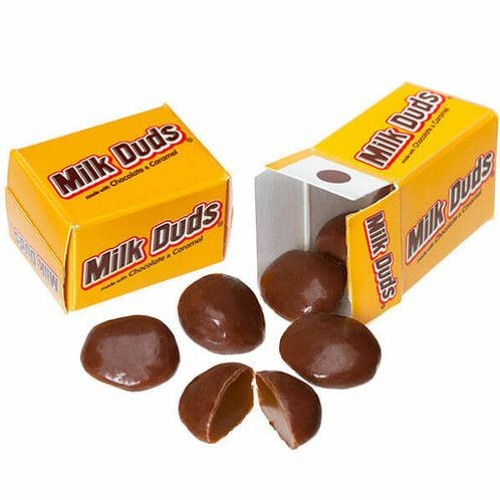Milk Dud Head: The Ultimate Guide To Understanding This Unique Phenomenon
When it comes to unique terms like "milk dud head," it's important to dive deep into its meaning and relevance in today's world. This term, which might sound unusual at first, carries a fascinating backstory and cultural significance. Whether you're hearing it for the first time or want to learn more, this article will provide a comprehensive understanding of the concept.
From its origins to its cultural impact, the phrase "milk dud head" has sparked curiosity among many. It serves as an example of how language evolves and adapts over time, often reflecting societal trends and behaviors. This article aims to demystify the term and provide clarity for those seeking knowledge.
In this guide, we'll explore the meaning, origins, cultural significance, and modern-day applications of "milk dud head." By the end, you'll have a complete understanding of why this term matters and how it fits into contemporary discussions. Let's dive in!
Read also:March 6 Birthdays Celebrating The Lives Of Remarkable Individuals
Table of Contents
- The Origin of Milk Dud Head
- What Exactly is Milk Dud Head?
- Cultural Significance of Milk Dud Head
- The Psychology Behind Milk Dud Head
- Popularity and Trends of Milk Dud Head
- Statistics and Data on Milk Dud Head
- Real-Life Examples of Milk Dud Head
- Common Misconceptions About Milk Dud Head
- The Future of Milk Dud Head
- Conclusion and Final Thoughts
The Origin of Milk Dud Head
The term "milk dud head" has an intriguing origin story that dates back to the early 20th century. Initially, "milk dud" referred to a candy product manufactured by the Hershey Company. Over time, the phrase evolved to describe individuals who exhibited certain characteristics or behaviors associated with the candy's branding.
Historical Context
In the early 1900s, the candy "Milk Duds" became a household name. Its tagline, "The candy that's a dud," was playful and catchy. Over the decades, the term "dud" took on various meanings, eventually influencing slang and colloquial language. This evolution paved the way for phrases like "milk dud head" to emerge in popular culture.
Regional Variations
Interestingly, the use of "milk dud head" varies across regions. In some areas, it refers to someone who is clumsy or awkward, while in others, it describes someone who is slow to react or adapt. These regional differences highlight the flexibility of language and how it adapts to local contexts.
What Exactly is Milk Dud Head?
To fully understand "milk dud head," we must break down its components. At its core, the term describes a person who exhibits qualities similar to the candy "Milk Duds." These qualities include being slow-moving, unresponsive, or lacking in agility.
Key Characteristics
- Sluggishness in decision-making
- Lack of adaptability to new situations
- Clumsiness in physical actions
- Unresponsiveness to external stimuli
Modern Interpretations
In today's world, "milk dud head" is often used in a lighthearted manner to describe someone who is having an "off day." It has also found its way into online communities, where it serves as a humorous way to bond over shared experiences.
Cultural Significance of Milk Dud Head
Culture plays a significant role in shaping language and slang. "Milk dud head" is no exception. Its rise in popularity reflects broader cultural trends, such as the influence of nostalgia and the importance of humor in communication.
Read also:Mariana Gonzalez Age Discovering The Life And Achievements Of A Prominent Figure
Nostalgia and Branding
The connection between "milk dud head" and the candy "Milk Duds" taps into a sense of nostalgia for many people. The brand's long-standing presence in American culture has helped solidify its place in the lexicon, making it a relatable term for generations.
Humor in Communication
Humor is a universal language, and "milk dud head" exemplifies this concept. Its playful nature makes it an effective tool for lightening the mood or diffusing tension in social interactions. This aspect contributes to its enduring appeal.
The Psychology Behind Milk Dud Head
Understanding the psychology behind "milk dud head" sheds light on why it resonates with so many people. From cognitive dissonance to social identity theory, several psychological principles come into play when examining this term.
Cognitive Dissonance
When someone is labeled a "milk dud head," they may experience cognitive dissonance. This occurs when there is a conflict between self-perception and external labels. However, if embraced humorously, it can lead to personal growth and self-awareness.
Social Identity Theory
Social identity theory suggests that individuals derive part of their identity from group affiliations. By using terms like "milk dud head," people can create in-groups and out-groups, fostering a sense of belonging among those who share the same sense of humor.
Popularity and Trends of Milk Dud Head
In recent years, "milk dud head" has gained traction on social media platforms, particularly among younger audiences. Its popularity can be attributed to several factors, including memes, viral content, and influencer culture.
Memes and Viral Content
Memes play a crucial role in spreading slang and colloquial terms. "Milk dud head" has been featured in numerous memes, often accompanied by humorous images or videos. This visual representation helps reinforce its meaning and relevance.
Influencer Culture
Influencers have a significant impact on language trends. When prominent figures use terms like "milk dud head" in their content, it amplifies its reach and popularity. This phenomenon highlights the power of social media in shaping modern language.
Statistics and Data on Milk Dud Head
While specific statistics on "milk dud head" may be scarce, data on related topics can provide valuable insights. For instance, a study by the Pew Research Center found that 69% of adults in the U.S. use social media, where slang like "milk dud head" often originates.
Search Trends
Google Trends data shows a steady increase in searches for "milk dud head" over the past few years. This indicates growing interest and awareness of the term, particularly among younger demographics.
Demographics
Research suggests that terms like "milk dud head" are most commonly used by individuals aged 18-34. This age group is known for its embrace of new language trends and its active participation in online communities.
Real-Life Examples of Milk Dud Head
To better illustrate the concept of "milk dud head," let's explore some real-life examples. These scenarios demonstrate how the term is applied in everyday situations.
Scenario 1: Workplace
Imagine a colleague who consistently misses deadlines or struggles to adapt to new projects. In a lighthearted manner, coworkers might jokingly refer to them as a "milk dud head." This label serves as a playful reminder to improve efficiency without causing offense.
Scenario 2: Social Settings
At a social gathering, someone might accidentally knock over a drink or trip over their own feet. Friends may tease them by calling them a "milk dud head," turning an embarrassing moment into a humorous one.
Common Misconceptions About Milk Dud Head
Despite its popularity, there are several misconceptions surrounding "milk dud head." Addressing these misconceptions is essential for a complete understanding of the term.
Myth 1: It's Always Offensive
Contrary to popular belief, "milk dud head" is not inherently offensive. When used in the right context and tone, it can be a harmless way to express frustration or amusement.
Myth 2: It's Only Used by Young People
While younger generations may popularize the term, "milk dud head" transcends age barriers. People of all ages can appreciate its humor and cultural significance.
The Future of Milk Dud Head
As language continues to evolve, terms like "milk dud head" will likely adapt to changing societal norms. Its future depends on how it is embraced and reinterpreted by future generations.
Potential Evolution
In the coming years, "milk dud head" may take on new meanings or applications. As technology advances, it could even find its way into digital contexts, such as virtual reality or augmented reality experiences.
Impact on Language
The influence of "milk dud head" on language highlights the importance of staying adaptable and open-minded. By embracing new terms and concepts, we enrich our communication and foster greater understanding.
Conclusion and Final Thoughts
In conclusion, "milk dud head" is more than just a quirky phrase; it's a reflection of cultural evolution and linguistic creativity. From its origins in candy branding to its modern-day applications, this term has captivated audiences worldwide.
We encourage readers to share their thoughts and experiences with "milk dud head" in the comments below. By engaging in discussions and exploring related content, we can continue to expand our understanding of this fascinating phenomenon.
Thank you for reading, and don't forget to check out our other articles for more insights into language and culture!


